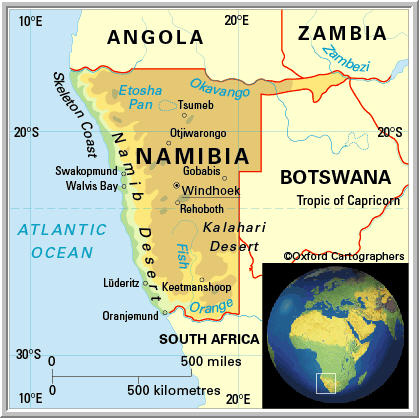Area:
825 418 square kilometers, 35th largest in the world. Namibia is approximately 3.37 times larger than the United Kingdom of Great Britain and Northern Ireland, and around 2 times larger than Sweden.
Regions:
The country is demarcated into 14 regions; Caprivi, Erongo, Hardap, Karas, Kavango West, Kavango East, Khomas, Kunene, Ohangwena, Omaheke, Omusati, Oshana, Oshikoto and Otjozondjupa.
Cities:
Windhoek (Capital City, Khomas region), Rundu (Kavango East region), Walvis Bay (Erongo region,), Oshakati (Oshana region), Swakopmund (Erongo region), Katima Mulilo (Caprivi region), Grootfontein (Otjozondjupa region), Okahandja (Otjozondjupa region), Otjiwarongo (Otjozondjupa region), Rehoboth (Hardap region), Gobabis (Omaheke region), Lüderitz (Karas region), Keetmanshoop (Karas region), Omuthiya (Oshikoto region).
Climate:
Arid and semi-arid. Hottest months, November to February (average temperatures, 20-36ºC). Colder months between May and August (average temperatures, 3-10ºC in the mornings and 18-22ºC during the day). The dry season is usually between April and October, and the rainy season usually November to March.
Topography:
Namibia has contrasting landscapes. The oldest desert in the world, the Namib Desert stretches along the whole west coast of the country, while the Kalahari Desert runs along its southeastern border with Botswana. The Skeleton Coast stretches from Swakopmund to the northern border.
Rivers:
Perennial rivers are found only on the country’s borders, being the Orange River on the southern border and the Kunene, Okavango, Kwando and Zambesi Rivers on the northern border.


